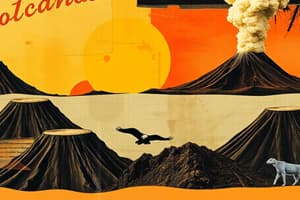Podcast
Questions and Answers
What is a characteristic feature of shield volcanoes?
What is a characteristic feature of shield volcanoes?
- Rapid formation during explosive eruptions
- Steep sides and small size
- Fluid basalt leading to gentle slopes (correct)
- High silica content
Which of the following is true about cinder cone volcanoes?
Which of the following is true about cinder cone volcanoes?
- They mainly produce lava flows rather than pyroclastic fragments.
- They are typically large and broad.
- They often form abruptly from a single eruptive event. (correct)
- They form from layering of lava and pyroclastic material.
What type of material do composite volcanoes primarily produce during eruptions?
What type of material do composite volcanoes primarily produce during eruptions?
- Volcanic gases only
- Fluid basalt lava flows
- Ash flows and pyroclastic flows (correct)
- Low-viscosity lava
Which feature distinguishes the structure of a shield volcano?
Which feature distinguishes the structure of a shield volcano?
Which notable eruption is linked to a composite volcano?
Which notable eruption is linked to a composite volcano?
What is a caldera?
What is a caldera?
Which feature is associated with pyroclastic flows?
Which feature is associated with pyroclastic flows?
What is one effect of volcanic eruptions on global climate?
What is one effect of volcanic eruptions on global climate?
What kind of volcanic activity tends to be more violent?
What kind of volcanic activity tends to be more violent?
Which volcano is known for its significant ash flow that buried Pompeii?
Which volcano is known for its significant ash flow that buried Pompeii?
What can be a sign of imminent volcanic eruption?
What can be a sign of imminent volcanic eruption?
What is the primary effect of the eruption of Mount Pinatubo in 1991?
What is the primary effect of the eruption of Mount Pinatubo in 1991?
What percentage of marine species were lost during the Permian extinction?
What percentage of marine species were lost during the Permian extinction?
Flashcards are hidden until you start studying
Study Notes
Shield Volcanoes
- Form from fluid basalt with low silica content
- Gentle slopes and large size
- Examples: Mauna Loa, Mauna Kea (Hawaii), Iceland
- Non-explosive eruptions create wide lava flows
Cinder Cone Volcanoes
- Formed from pyroclastic fragments (volcanic debris)
- Steep, small and symmetrical shape
- Form rapidly, often in a single eruption
- Example: Sunset Crater in Arizona
Composite Volcanoes
- Layers of lava and pyroclastic material create a hard, erosion-resistant surface
- Steep sides and tall shape
- Made from andesitic magma with high silica content
- Examples: Mount St. Helens, Mount Rainier (Washington), Mount Vesuvius (Italy)
Caldera
- Collapsed, evacuated magma chamber
- Steep-walled, circular, large (40+ km in diameter)
- Examples: Yellowstone caldera (three calderas with eruptions 1.9 and 0.6 million years ago) and Yosemite's Long Valley (Bishop Tuff)
Pyroclastic Flows
- Column of pyroclastic materials and gas
- Hot (1000°C or 1800°F) and fast (700 kph or 450 mph)
- Travel long distances (up to 100 km or 62 mi)
- Examples: Nueè ardente "glowing cloud"
Ash Flow Tuff
- Ash welded or compacted after flow
- Example: Mount Vesuvius (buried Pompeii and Herculaneum in 79 AD)
Volcanic Eruptions Prediction: Regional
- Areas most likely for eruptions: subduction zones, spreading centers, hotspots
Volcanic Prediction: Short Term
- Changes in shape, earthquakes swarms, gas/ash emission, temperature anomalies
- Examples:
- Mount St. Helens (1980)
- Montserrat (1997)
Volcanic Eruptions and Global Climate
- Examples:
- Pinatubo eruption (1991) caused global cooling
- Permian extinction (225 million years ago) linked to Siberian flood basalts
Mantle Carbon
- Basalt eruptions release CO2 (0.44% weight/weight).
- Large volcanic eruptions can influence global temperatures, both warming and cooling.
Studying That Suits You
Use AI to generate personalized quizzes and flashcards to suit your learning preferences.




